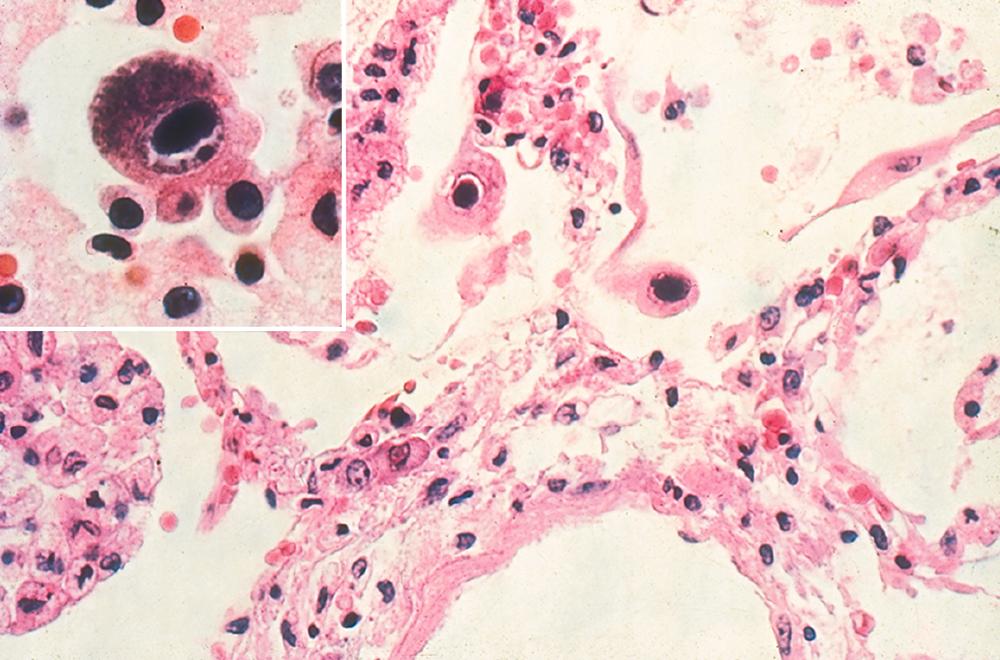Physical Address
304 North Cardinal St.
Dorchester Center, MA 02124
Cytomegalovirus (CMV) is a member of the herpesvirus family and shares, with the other members, the ability to establish a long-lived latent infection. Most of the clinical diseases caused by this virus result from reactivation of latent virus in immune-impaired patients, although primary infection in such patients can also lead to significant disease.
CMV has a linear, double-stranded DNA genome with about 236,000 base pairs that encode about 167 proteins. On microscopic examination, the hallmark of tissue infection is a large (cytomegalic), 25- to 35-µm cell containing a large central, basophilic intranuclear inclusion ( Fig. 347-1 ), referred to as an owl’s eye.

Multiple mechanisms account for the spread of this virus, including vertical (in utero, during vaginal delivery, and by breast milk) and horizontal (saliva, genital, urine, blood) contact. These routes of transmission lead, collectively, to a 15 to 20% seroprevalence by 15 years of age in developed countries, with a higher seroprevalence in lower socioeconomic settings. From that age on, there is a steady upward trend of 1 to 2% per year that is due in part to sexual transmission. As a result, approximately 50% of the general population of the United States is antibody positive by 35 years of age, and a 1% per year rate of increase occurs thereafter. In underdeveloped countries, up to 90% of persons may be seropositive by 2 years of age. Presumably, crowded living conditions permit spread of the virus through close contact with body fluids. A study showed that CMV was viable on metal and wood for up to 1 hour, glass and plastic up to 3 hours, and rubber, cloth, and crackers up to 6 hours. CMV was more likely to be isolated from wet, highly absorbent surfaces. These considerations were felt to be particularly important because children may actively shed CMV in saliva and urine for months to years, and exposure to bodily fluids from young children poses substantial risk for CMV exposure among women of reproductive age. Two additional mechanisms of transmission are blood transfusion and organ transplantation. A final important epidemiologic fact is that reinfection with a different strain of CMV may occur in CMV-seropositive persons, especially those who are immunocompromised or pregnant or have multiple sexual partners.
In immunocompetent individuals, CMV rarely causes clinically evident end-organ disease. When immune mechanisms are deficient, especially mechanisms mediated by CD4 + and CD8 + lymphocytes, latent virus replicates and causes both direct and indirect effects. Examples of direct virally mediated diseases are necrotizing CMV retinitis and esophagitis. In contrast, CMV pneumonitis is frequently manifested as subtle histologic alterations accompanied by limited viral replication, thereby suggesting that immune-mediated injury may be the primary pathologic mechanism. Such injury may result from the upregulation and release of cytokines, including tumor necrosis factor-α, interferon-γ, and interleukin-2. Immune-mediated tissue injury may also be effected by CD8 + cytotoxic T lymphocytes directed against CMV-infected target cells. The clinical manifestations of CMV infection, including meningoencephalitis, retinitis, enteritis, vasculitis, pneumonitis, myocarditis, lymphadenitis, hepatitis, adrenalitis, and pancreatitis, reflect the range of cell types that CMV is capable of infecting. The indirect effects of CMV include increased risks of some bacterial infections and invasive fungal diseases, reactivation of other herpesviruses, immunosenescence, rejection, graft loss, and death.
The immune response to CMV infection involves both the humoral and cell-mediated arms, and T-cell responses appear to be the most important for controlling reactivated infection. The CMV envelope glycoproteins that participate in viral entry are gB, gH/gL, and gCII, as components of the pentameric complex. Humoral immunity directed at gB has been detected in convalescent phase sera and has been shown to block viral entry, cell-to-cell transmission, and syncytium formation in CMV-infected cells. Not surprisingly, components of the pentameric complex are the primary target of experimental vaccines.
Fundamental to the pathogenesis of CMV is latency, or persistence of the viral genome in host cells without evidence of productive viral replication. It is thought that monocytes and bone marrow progenitor cells are sites of human CMV latency. Reactivation from latency has classically been associated with immunosuppression. Exposure to a rich milieu of cytokines and growth factors results in the activation of signal transduction pathways, generation of increased levels of intracellular transcription factors, and production of viable virus.
In the developed world, congenital infection occurs in approximately 0.2 to 0.7% of newborns. Thus, in the United States, each year approximately 40,000 infants are born excreting CMV, and about 4000 (or ~10%) of these newborns show clinical evidence of congenital disease, such as microcephaly, intracerebral calcification, hepatosplenomegaly, and rash. About 90% of these clinically infected newborns will survive, but half of the survivors will have unilateral or bilateral hearing loss, developmental delay, or both. Mothers of most infants with symptomatic CMV infection had a primary infection during pregnancy, although it is now well known that clinically evident congenital infection also occurs in infants born to mothers with past CMV infection. In mothers with a primary infection, a negative amniocentesis markedly reduces the likelihood of hearing impairment and makes more serious sequelae very unlikely. In newborns who are born to women with primary CMV infection but are initially asymptomatic, a higher viral load may increase the risk for subsequent CMV-related sequelae. Up to 14% of asymptomatic infected babies at birth will eventually develop learning problems or hearing loss.
Become a Clinical Tree membership for Full access and enjoy Unlimited articles
If you are a member. Log in here